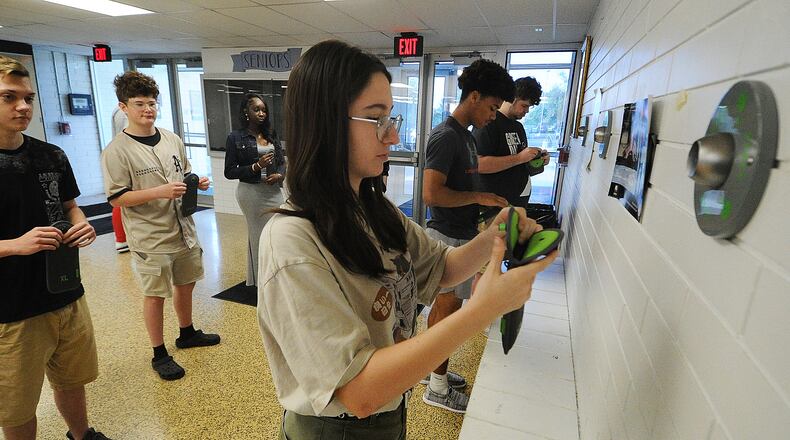“From my policy perspective, one of the significant changes is that the policy must emphasize that student cellular telephone use be as limited as possible during school hours and reduce cellular telephone-related distractions in classroom settings,” said Kenna S. Haycox, deputy director of board and management services at the Ohio School Boards Association.
The law change came after an amendment to an existing bill, House Bill 250, about military seals on state diplomas. Earlier this year, DeWine called on the Ohio General Assembly during his State of the State address to help schools get cell phones out of classrooms. Many educators say cell phones are a distraction to students and a pathway to bullying.
Most local school districts already require students to keep their cell phones, personal laptops and headphones, among other devices, out of sight during the school day. A handful of schools, including Dayton Public and Fairborn, use Yondr pouches, which lock the student’s phone in a magnetic pouch during the day that kids unlock with a special key.
As a result of the new law, the Ohio Department of Education and Workforce is required to publish a model policy regarding personal devices that schools across the state can reference as they create their policies.
Neola is an independent school policy provider for many local schools including Troy, Northmont and Oakwood. The change in the law may simplify policies for some districts, said Neola’s executive director of policy services, Angela De Los Santos.
De Los Santos said districts in Ohio had many options to write a policy around personal communication devices before this bill and there may just be additional tweaks that schools who use Neola’s policies will need to add.
“We just might recommend that they incorporate some of this specific language from this legislation, but I don’t know yet,” she said. “So, we’re taking a look at it.”
The new bill also provides some exceptions for use around students who have individualized education programs (IEPs) which are often used for students who have an additional need, such as a phone to monitor their insulin or an app to communicate with school staff.
Teachers can allow students to use personal devices in their classes under the new law.
Haycox encouraged schools to look at the language around cell phones as soon as possible and make any needed changes.
“We want districts to be able to make informed decisions about the policy that best meets their local needs,” Haycox said.
What are some local schools’ plans?
Beavercreek High School plans to begin using Yondr pouches this coming school year, said Anaka Rettig, spokeswoman for the district.
“We arrived at this procedural change as a result of a focused study on student data and honest reflection about student cell phones on campus,” high school administrators said in a recent letter to parents. “The goal of this procedure is to reduce the potential harm of cell phone usage during the school day while creating a safer school environment that maximizes teachers’ ability to educate their students.”
Oakwood schools superintendent Neil Gupta said the district will work with Neola on any policy changes.
“Schools are required to adopt their cell phone policy no later than July 2025, so we have time to be thoughtful in what decisions are made and how they will be communicated to staff, students, and families,” Gupta said.
Alex Kincaid, a spokeswoman for Dayton Public Schools, said the policies for DPS high school and middle schools vary.
“In the coming months, the District’s Policy Committee will be developing a policy that would then be presented to the board for approval,” she said.
Kettering doesn’t allow students to use cell phones during the school day without teacher permission, according to the handbook. Centerville requires students to keep phones and electronic watches turned off and in lockers. Both districts said they’ll review their policies once more information is available.
Jason Enix, Huber Heights superintendent, said the district has a policy on acceptable use for technology, but not cell phones specifically. Handbooks at each school say phones are only to be used at non-academic times at the high school or at a teacher’s request, and same at the middle and elementary schools. Middle and elementary school students can’t wear headphones during the day unless a teacher allows it.
“We review handbooks every year, but believe that the current language addresses the spirit of HB 250,” Enix said.
About the Author

